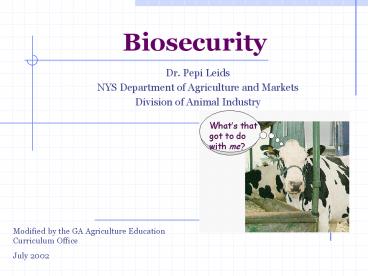Biosecurity - PowerPoint PPT Presentation
1 / 23
Title:
Biosecurity
Description:
228/lactating cow. BVD: 1 infected = persistently infected calves for years $475/lactating cow. Why Biosecurity? Preventive approach to herd health ... – PowerPoint PPT presentation
Number of Views:412
Avg rating:3.0/5.0
Title: Biosecurity
1
Biosecurity
- Dr. Pepi Leids
- NYS Department of Agriculture and Markets
- Division of Animal Industry
Modified by the GA Agriculture Education
Curriculum Office July 2002
2
Why Should You Care?
- Infectious diseases cost dairy producers
production and profit - We are seeing increases in antibiotic resistance,
making diseases harder to treat effectively - We are in the FOOD business
3
Why Should You Care?
- Many clinical diseases represent the tip of the
iceberg - Johnes 1 clinical 15 - 25 subclinically
infected - 228/lactating cow
- BVD 1 infected persistently infected calves
for years - 475/lactating cow
4
Why Biosecurity?
- Preventive approach to herd health
- Reduce the herds risk for contracting or
spreading a disease - Often requires only management changes, not
capital investment
5
What is Biosecurity?
- A collection of management practices which
protect a herd from the entry of new diseases and
minimizes the spread and/or adverse effects of
disease within a herd.
6
The Animal Health Triad
7
Immunity and Challenge
Disease
Subclinical Disease, Poor Production, Reduced
Efficiency
Immunity (Immunity x Environment)
Challenge (Disease Agent x Environment)
8
Putting Biosecurity to Work
- Minimize exposure to disease agents
- Develop immunity
- Manage environment to support above points
9
Reducing Exposure to Disease
- Consider the paths for disease entry or spread
- Cattle
- purchased animals, heifers returning from grower,
show animals - Manure
- Pests, pets, wildlife
- Feed
- Water
- Take steps to minimize your risk
10
Cattle
- Single source you can inspect
- Known health history
- Primary secondary vaccine weeks before move
- Test as appropriate
- BVD-PI, Johnes, contagious mastitis, heel warts,
salmonella - Protect the home herd
11
Transport
- Insist on clean transport
- washed between uses
- 60 of trucks contaminated with salmonella
- Dont group animals from other farms
- Trained, conscientious haulers
- Minimize stress
12
Minimize Animal Contact
- Pets
- cats, dogs, chickens, geese
- Pests
- rodents, birds, wildlife
13
Manure Management
- Avoid mixing with feed
- Consider flows
- near feed storage
- near youngstock
- Watch for carriers
- equipment
- people
- spreading
14
Feedstuffs - Mill to Farm
- Rodent and bird control in feedmills
- vectors for many bacterial diseases
- Cleanliness of delivery trucks
- alternatives to delivery at the barn
- Drivers enter facilities only when necessary
15
Keep Feed Clean
- Rodent and bird control in storage
- Dont use manure equipment in feed handling
- Preach caution in pushing up feed
- Be alert for areas where manure could mix with
feed
16
Dont Tolerate Fomites
- Every visitor should clean sanitize
- clothes
- boots
- hands
- equipment
- Discourage visitors from
- entering facilities unnecessarily
- parking near or working with youngstock
- moving between different groups unnecessarily
- Consider the order of work routines
17
Manage the Environment
- Increase cow comfort through
- Good stall design
- assess utilization, lunging, resting posture
- Proper ventilation
- Proper footing
- Grouping cattle to decrease disruption
18
Calving Area Management
- Maternity pen is the highest priority area
- clean and dry
- single use
- not a hospital pen
- separate from cows
- motel 6
19
Neonatal Management
- Test for BVD-PI status before colostrum
- Colostrum
- 4 quarts ASAP
- from calfs own dam or Johnes free cow
- NO pooled colostrum
- Dip navel
- Remove calf ASAP
20
Environment
- Nutrition
- balanced for growth or production
- analyze supplement
- Vit. A E, Cu, Se, Zn
- avoid molds mycotoxins
- suppress immunity
- pay attention to forage moisture levels and
particle length - can alter rumen and intestinal pH, making harmful
bugs more viable
21
Immunity
- Consult with your own customers vets
- Establish vaccination program which addresses
diseases from all your customers - Keep records of vaccinations
22
Cow Calf Immunity
- Role of vaccines colostrum
- protects calf from diseases transferred across
placenta - provides important passive immunity for the calf
- should take into account any bugs that heifers
might encounter on your farm
23
Summary
- Avoid the entry or spread of pathogens
- cattle, manure, feed, water, equipment, people
- Manage the environment to
- reduce spread of disease
- optimize immunity
- Maximize immunity
- optimal passive transfer fetal colostral
- sound vaccination program rigorously adhered to































